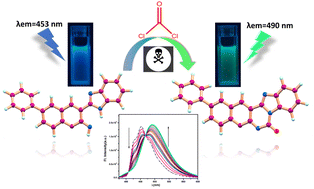Fluorescent chemosensor detecting a widely used but highly toxic chemical warfare agent (CWA) such as phosgene is of great importance due to its high sensitivity along with low cost and simple method of preparation. In this study a biphenyl-benzoimidazole based (BPCI) chemodosimeter, which displayed a rapid, sensitive and ratiometric detection of the lethal pulmonary agent phosgene, has been developed. Upon the addition of phosgene to the BPCI solution in THF, we observed a fluorescence color change from blue to cyan-green. The chemodosimeter (BPCI) undergoes nucleophilic substitution reaction with phosgene followed by ring closure to yield the carbamylated final product and shows an explicit ratiometric fluorescence response towards phosgene. The carbamylation was accelerated due to the formation of a six-member ring, which restricts the C–C bond rotation. The probe (BPCI) selectively detected phosgene over other toxic relevant analytes. The detection limit (LOD) of BPCI for phosgene was established to be in the order of 10−7 M in the solution phase, which implied that BPCI can detect phosgene at a very minuscule level. This ratiometric switch, which we developed, can be used as a potential portable kit for detecting phosgene in the vapour phase, as well as in the solid phase when supported upon TLC plates. Theoretical calculations using the DFT/B3LYP/6-31+G(d) method were performed to unveil the electronic properties theoretically and to interpret the probable sensing mechanism.
